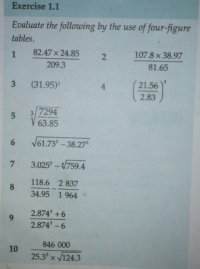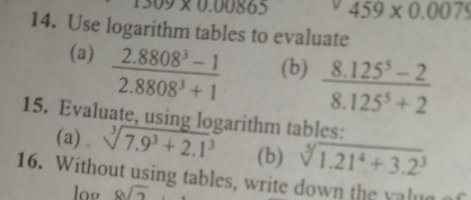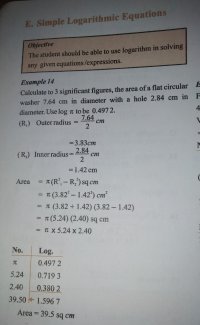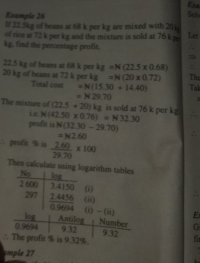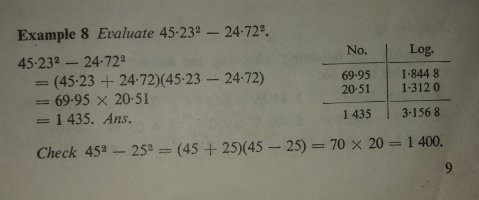I need help with this:
Evaluate the following by the use of four-figure table.
\(\displaystyle a.~ 3.025^3 - \sqrt[4]{759.4}\)
\(\displaystyle b. ~\frac{118.6}{34.95} - \frac{2837}{1964}\)
\(\displaystyle c. ~\frac{2.874^3+6}{2.874^3-6}\)
\(\displaystyle d. ~2.908^3 + \sqrt[5]{248.4}\)
\(\displaystyle e. ~\sqrt[3]{130-\sqrt[3]{130}}\)
\(\displaystyle f. ~11.65 × 91.21-11.65^2\)
\(\displaystyle g. ~\sqrt[5]{1.21^4+3.2^3}\)
l am having difficulty when it comes to working with problems involving addition and subtractions.
I have no problem working with these ones below because the operations do not involve addition and subtraction. Please take a look at them:
\(\displaystyle i. ~\sqrt{\frac{173.8×14.7^2}{2.61^3}}\)
\(\displaystyle ii. ~\frac{42.79×\sqrt{0.6154}}{8.737×25.61}\)
\(\displaystyle iii. ~\sqrt[3]{\left(\frac{565×0.0536}{249.1}\right)^2}\)
solutions
\(\displaystyle i. ~\sqrt{\frac{173.8×14.7^2}{2.61^3}}\)
[math]\begin{array}{|l|r|} \text{No.} & \text{Log} \\ \hline 173.8 & 2.2400 \\ \hline 14.7^2 & 1.1673 × 2 \\ \hline ~ & = 2.3346 \\ \hline 173.8 × 14.7^2 & 2.2400 \\ ~ & + 2.3346 \\ ~ & \overline{4.5746} \\ \hline 2.61^3 & 0.4166 × 3 \\ \hline ~ & = 1.2499 \\ \hline \frac{173.8 × 14.7^2}{2.61^3} & 4.5746 \\ ~ & -1.2499 \\ ~ & =\\ \hline ~ & 3.3247 \\ \hline \sqrt{\frac{173.8 × 14.7^2}{2.61^3}} & 3.3247 ÷ 2 \\ ~ & = 1.6624 \\ ~ & \text{antilog of} \\ ~ & 1.6624 \bumpeq 45.96 \\ \end{array} [/math]
\(\displaystyle \sqrt{\frac{173.8×14.7^2}{2.61^3}}=45.96\)
\(\displaystyle ii. ~\frac{42.79×\sqrt{0.6154}}{8.737×25.61}\)
[math]\begin{array}{|l|r|r|} \text{No.} & \text{Log} & ~ \\ \hline 42.79 & 1.6313 & 1.61313 \\ 0.6154^\frac{1}{2} & \bar{1}.7892 ÷ 2 & ~ \\ ~ & (\bar{1} + 0.7892) ÷ 2 & ~ \\ ~ & (\bar{2} + 0.7892) ÷ 2 & + \\ ~ & (\bar{1} + 0.8946) & \bar{1}.8946 \\ ~ & ~ & \overline{1.5259} \\ 8.737 & 0.9413 & - \\ 25.61 & +1.4084 & 2.3497 \\ \hline 0.1505 & \bar{1}.1762 & ~ \\ \hline \end{array} [/math]
\(\displaystyle ~\frac{42.79×\sqrt{0.6154}}{8.737×25.61} = 0.1501\)
\(\displaystyle iii. ~\sqrt[3]{\left(\frac{565×0.0536}{249.1}\right)^2}\)
[math]\begin{array}{|l|r|} \text{Number} & \text{Logarithm} \\ \hline 565 & 2.7520 \\ 0.0536 & \bar{2}.7292 \\ 565 × 0.0536 & \overline{1.4812} \\ 249.1 & 2.3964 \\ \frac{565×0.0536}{249.1} & \overline{\bar{1}.0848} \\ \left(\frac{565×0.0536}{249.1}\right)^2 & \bar{1}.0848 × 2 = \bar{2}.1696 \\ \sqrt[3]{\left(\frac{565×0.0536}{249.1}\right)^2} & = \frac{1}{3}(\bar{2}.1696)=\frac{1}{3}(\bar{3} + 1.1696) \\ ~ & = \bar{1}.389~86 \\ ~ & \bumpeq{\bar{1}.3899} \end{array} [/math]
\(\displaystyle ~\sqrt[3]{\left(\frac{565×0.0536}{249.1}\right)^2}\)
\(\displaystyle = \text{antilog of}~\bar{1}.3899\)
\(\displaystyle = 10^{-1} × 2.454\)
\(\displaystyle = 0.2454\)
\(\displaystyle = 0.245 (3 \text{s.f})\)
I was able to solve i, ii and iii because there was no addition subtraction involved. Now let me take a few shots at some of the problems involving subtraction and addition.
\(\displaystyle s1.~ \frac{2.8808^3-1}{2.8808^3+1}\)
\(\displaystyle s2.~\sqrt[3]{7.9^3 + 2.1^3}\)
\(\displaystyle s3.~\sqrt{61.73^2 - 38.27^2}\)
\(\displaystyle s4.~\sqrt[3]{9.58^3 - 7.63^3}\)
Solutions
\(\displaystyle s1.~ \frac{2.8808^3-1}{2.8808^3+1}\)
Using the idea of difference and sum of two cubes at the numerator and denominator respectively to simplify first.
\(\displaystyle \frac{2.8808^3-1}{2.8808^3+1}=\)
\(\displaystyle \frac{(2.8808-1)(2.8808^2+2.8808+1)}{(2.8808+1)(2.8808^2-2.8808+1)}=\)
\(\displaystyle \frac{(1.8808)(12.18)}{(3.8808)(6.418)}=\)
\(\displaystyle \frac{22.91}{24.91}\)
Putting the simplified expression in a table we have
[math]\begin{array}{|l|r|} \text{No.} & \text{Log} \\ \hline \frac{22.91}{24.91} & 1.3600 \\ & - \\ ~ & 1.3964 \\ \hline 0.9196 & \bar{1}.9636 \end{array}[/math]
Antilog of \(\displaystyle \bar{1}.9636=0.9196\)
\(\displaystyle \frac{2.8808^3-1}{2.8808^3+1}=0.9196\)
\(\displaystyle s2.~\sqrt[3]{7.9^3 + 2.1^3}\)
applying the sum of two cubes
\(\displaystyle \sqrt[3]{7.9^3 + 2.1^3}=\)
\(\displaystyle \sqrt[3]{(7.9 + 2.1)(7.9^2-(7.9)(2.1)+2.1^2)}=\)
\(\displaystyle \sqrt[3]{(10)(62.41-16.59+4.41)}=\)
\(\displaystyle \sqrt[3]{(10)(50.23)}=\)
\(\displaystyle \sqrt[3]{502.3}=\)
putting in table
[math]\begin{array}{|l|r|} \text{No.} & \text{Log} \\ \hline \sqrt[3]{502.3} & 2.701 × \frac{1}{3} \\ & = 0.9003 \end{array}[/math]antilog of \(\displaystyle 0.9003=7.949\)
\(\displaystyle \sqrt[3]{7.9^3 + 2.1^3}=7.949\)
\(\displaystyle s3.~\sqrt{61.73^2 - 38.27^2}\)
applying the idea of difference of two squares:
\(\displaystyle \sqrt{61.73^2 - 38.27^2}=\)
\(\displaystyle \sqrt{(61.73 + 38.27)(61.73 - 38.27)}=\)
\(\displaystyle \sqrt{(100)(23.46)}=\)
\(\displaystyle \sqrt{2346}\)
Putting in table, we be have:
[math]\begin{array}{|l|r|} \text{No.} & \text{Log} \\ \hline \sqrt{2346} & 3.3703 ÷ 2 \\ & = 1.6852 \end{array}[/math]antilog of 1.6852 = 48.44 so
\(\displaystyle \sqrt{61.73^2 - 38.27^2}=48.44\)
\(\displaystyle s4.~\sqrt[3]{9.58^3 - 7.63^3}\)
applying difference of two cubes, we have
\(\displaystyle \sqrt[3]{9.58^3 - 7.63^3}=\)
\(\displaystyle \sqrt[3]{(9.58 - 7.63)(9.58^2 + (9.58)(7.63) + 7.63^2)}=\)
\(\displaystyle \sqrt[3]{(1.95)(91.7764 + 73.0954 + 58.2169)}=\)
\(\displaystyle \sqrt[3]{(1.95)(223.0887)}=\)
\(\displaystyle \sqrt[3]{435.0230}=\)
putting in table, we have:
[math]\begin{array}{|l|r|} \hline \text{No.} & \text{Log} \\ \hline \sqrt[3]{435.0230} & 2.6385 ÷ 3 \\ \hline 7.577 & = 0.8795 \\ \hline \end{array}[/math]
\(\displaystyle \sqrt[3]{9.58^3 - 7.63^3}=7.577\)
As I said earlier, I need help with a to g. I don't know how to go about them because of the minus - and plus + sign involved. Thank you.
Evaluate the following by the use of four-figure table.
\(\displaystyle a.~ 3.025^3 - \sqrt[4]{759.4}\)
\(\displaystyle b. ~\frac{118.6}{34.95} - \frac{2837}{1964}\)
\(\displaystyle c. ~\frac{2.874^3+6}{2.874^3-6}\)
\(\displaystyle d. ~2.908^3 + \sqrt[5]{248.4}\)
\(\displaystyle e. ~\sqrt[3]{130-\sqrt[3]{130}}\)
\(\displaystyle f. ~11.65 × 91.21-11.65^2\)
\(\displaystyle g. ~\sqrt[5]{1.21^4+3.2^3}\)
l am having difficulty when it comes to working with problems involving addition and subtractions.
I have no problem working with these ones below because the operations do not involve addition and subtraction. Please take a look at them:
\(\displaystyle i. ~\sqrt{\frac{173.8×14.7^2}{2.61^3}}\)
\(\displaystyle ii. ~\frac{42.79×\sqrt{0.6154}}{8.737×25.61}\)
\(\displaystyle iii. ~\sqrt[3]{\left(\frac{565×0.0536}{249.1}\right)^2}\)
solutions
\(\displaystyle i. ~\sqrt{\frac{173.8×14.7^2}{2.61^3}}\)
[math]\begin{array}{|l|r|} \text{No.} & \text{Log} \\ \hline 173.8 & 2.2400 \\ \hline 14.7^2 & 1.1673 × 2 \\ \hline ~ & = 2.3346 \\ \hline 173.8 × 14.7^2 & 2.2400 \\ ~ & + 2.3346 \\ ~ & \overline{4.5746} \\ \hline 2.61^3 & 0.4166 × 3 \\ \hline ~ & = 1.2499 \\ \hline \frac{173.8 × 14.7^2}{2.61^3} & 4.5746 \\ ~ & -1.2499 \\ ~ & =\\ \hline ~ & 3.3247 \\ \hline \sqrt{\frac{173.8 × 14.7^2}{2.61^3}} & 3.3247 ÷ 2 \\ ~ & = 1.6624 \\ ~ & \text{antilog of} \\ ~ & 1.6624 \bumpeq 45.96 \\ \end{array} [/math]
\(\displaystyle \sqrt{\frac{173.8×14.7^2}{2.61^3}}=45.96\)
\(\displaystyle ii. ~\frac{42.79×\sqrt{0.6154}}{8.737×25.61}\)
[math]\begin{array}{|l|r|r|} \text{No.} & \text{Log} & ~ \\ \hline 42.79 & 1.6313 & 1.61313 \\ 0.6154^\frac{1}{2} & \bar{1}.7892 ÷ 2 & ~ \\ ~ & (\bar{1} + 0.7892) ÷ 2 & ~ \\ ~ & (\bar{2} + 0.7892) ÷ 2 & + \\ ~ & (\bar{1} + 0.8946) & \bar{1}.8946 \\ ~ & ~ & \overline{1.5259} \\ 8.737 & 0.9413 & - \\ 25.61 & +1.4084 & 2.3497 \\ \hline 0.1505 & \bar{1}.1762 & ~ \\ \hline \end{array} [/math]
\(\displaystyle ~\frac{42.79×\sqrt{0.6154}}{8.737×25.61} = 0.1501\)
\(\displaystyle iii. ~\sqrt[3]{\left(\frac{565×0.0536}{249.1}\right)^2}\)
[math]\begin{array}{|l|r|} \text{Number} & \text{Logarithm} \\ \hline 565 & 2.7520 \\ 0.0536 & \bar{2}.7292 \\ 565 × 0.0536 & \overline{1.4812} \\ 249.1 & 2.3964 \\ \frac{565×0.0536}{249.1} & \overline{\bar{1}.0848} \\ \left(\frac{565×0.0536}{249.1}\right)^2 & \bar{1}.0848 × 2 = \bar{2}.1696 \\ \sqrt[3]{\left(\frac{565×0.0536}{249.1}\right)^2} & = \frac{1}{3}(\bar{2}.1696)=\frac{1}{3}(\bar{3} + 1.1696) \\ ~ & = \bar{1}.389~86 \\ ~ & \bumpeq{\bar{1}.3899} \end{array} [/math]
\(\displaystyle ~\sqrt[3]{\left(\frac{565×0.0536}{249.1}\right)^2}\)
\(\displaystyle = \text{antilog of}~\bar{1}.3899\)
\(\displaystyle = 10^{-1} × 2.454\)
\(\displaystyle = 0.2454\)
\(\displaystyle = 0.245 (3 \text{s.f})\)
I was able to solve i, ii and iii because there was no addition subtraction involved. Now let me take a few shots at some of the problems involving subtraction and addition.
\(\displaystyle s1.~ \frac{2.8808^3-1}{2.8808^3+1}\)
\(\displaystyle s2.~\sqrt[3]{7.9^3 + 2.1^3}\)
\(\displaystyle s3.~\sqrt{61.73^2 - 38.27^2}\)
\(\displaystyle s4.~\sqrt[3]{9.58^3 - 7.63^3}\)
Solutions
\(\displaystyle s1.~ \frac{2.8808^3-1}{2.8808^3+1}\)
Using the idea of difference and sum of two cubes at the numerator and denominator respectively to simplify first.
\(\displaystyle \frac{2.8808^3-1}{2.8808^3+1}=\)
\(\displaystyle \frac{(2.8808-1)(2.8808^2+2.8808+1)}{(2.8808+1)(2.8808^2-2.8808+1)}=\)
\(\displaystyle \frac{(1.8808)(12.18)}{(3.8808)(6.418)}=\)
\(\displaystyle \frac{22.91}{24.91}\)
Putting the simplified expression in a table we have
[math]\begin{array}{|l|r|} \text{No.} & \text{Log} \\ \hline \frac{22.91}{24.91} & 1.3600 \\ & - \\ ~ & 1.3964 \\ \hline 0.9196 & \bar{1}.9636 \end{array}[/math]
Antilog of \(\displaystyle \bar{1}.9636=0.9196\)
\(\displaystyle \frac{2.8808^3-1}{2.8808^3+1}=0.9196\)
\(\displaystyle s2.~\sqrt[3]{7.9^3 + 2.1^3}\)
applying the sum of two cubes
\(\displaystyle \sqrt[3]{7.9^3 + 2.1^3}=\)
\(\displaystyle \sqrt[3]{(7.9 + 2.1)(7.9^2-(7.9)(2.1)+2.1^2)}=\)
\(\displaystyle \sqrt[3]{(10)(62.41-16.59+4.41)}=\)
\(\displaystyle \sqrt[3]{(10)(50.23)}=\)
\(\displaystyle \sqrt[3]{502.3}=\)
putting in table
[math]\begin{array}{|l|r|} \text{No.} & \text{Log} \\ \hline \sqrt[3]{502.3} & 2.701 × \frac{1}{3} \\ & = 0.9003 \end{array}[/math]antilog of \(\displaystyle 0.9003=7.949\)
\(\displaystyle \sqrt[3]{7.9^3 + 2.1^3}=7.949\)
\(\displaystyle s3.~\sqrt{61.73^2 - 38.27^2}\)
applying the idea of difference of two squares:
\(\displaystyle \sqrt{61.73^2 - 38.27^2}=\)
\(\displaystyle \sqrt{(61.73 + 38.27)(61.73 - 38.27)}=\)
\(\displaystyle \sqrt{(100)(23.46)}=\)
\(\displaystyle \sqrt{2346}\)
Putting in table, we be have:
[math]\begin{array}{|l|r|} \text{No.} & \text{Log} \\ \hline \sqrt{2346} & 3.3703 ÷ 2 \\ & = 1.6852 \end{array}[/math]antilog of 1.6852 = 48.44 so
\(\displaystyle \sqrt{61.73^2 - 38.27^2}=48.44\)
\(\displaystyle s4.~\sqrt[3]{9.58^3 - 7.63^3}\)
applying difference of two cubes, we have
\(\displaystyle \sqrt[3]{9.58^3 - 7.63^3}=\)
\(\displaystyle \sqrt[3]{(9.58 - 7.63)(9.58^2 + (9.58)(7.63) + 7.63^2)}=\)
\(\displaystyle \sqrt[3]{(1.95)(91.7764 + 73.0954 + 58.2169)}=\)
\(\displaystyle \sqrt[3]{(1.95)(223.0887)}=\)
\(\displaystyle \sqrt[3]{435.0230}=\)
putting in table, we have:
[math]\begin{array}{|l|r|} \hline \text{No.} & \text{Log} \\ \hline \sqrt[3]{435.0230} & 2.6385 ÷ 3 \\ \hline 7.577 & = 0.8795 \\ \hline \end{array}[/math]
\(\displaystyle \sqrt[3]{9.58^3 - 7.63^3}=7.577\)
As I said earlier, I need help with a to g. I don't know how to go about them because of the minus - and plus + sign involved. Thank you.

